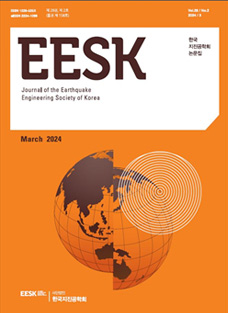![]() Journal Search Engine
Journal Search Engine
ISSN : 2234-1099(Online)
DOI : https://doi.org/10.5000/EESK.2012.16.1.001
뒷채움이 부실한 묻힌기초 위에 세워진 건축물의 지반증폭계수에 대한 저감계수
Reduction Factor for the Site Coefficient of a Building built on a Poor-backfilled Embedded Foundation
Abstract
- 1. Introduction
- 2. Seismic Response Analysis Model of Structure-Soil System
- 3. Site Coefficients of Linear Soil Layer ignoring Backfill around Embedded Foundation
- 4. Conclusions
- Acknowledgment
- (1)11-19.pdf933.8KB
1. Introduction
In the seismic design of a building it is essential to consider the site soil condition and the effects of the structure-soil interaction for the reasonable prediction of the design response acceleration of a building. Site coefficients specified in International Building Code (IBC)(1) and Korean Building Code (KBC)(2) are applicable to the seismic analyses of a building built on the surface foundation in the practical point of view, and they could lead the seismic design of a building with an embedded foundation too conservative causing the considerable increase of the construction cost.
It is necessary to perform a seismic design through the site specific analysis of the foundation-soil system instead of applying the site coefficients specified in the code to take account into the seismic advantages of an embedded foundation. However, it is quite complicate and difficult work for professional engineers who are not familiar with the theoretical knowledge of the structure-soil interaction to perform the site specific analysis of the foundation-soil system. The site specific analysis have to be performed with the specialized 3D finite element software which is not available for the practical use.(3) Therefore it would be useful to systemize the process to find the site coefficients of the embedded foundation-soil system to solve the practical difficulty and to reflect the site coefficients of the embedded foundation-soil system on the seismic design code in the rational and logical manner. In this paper, the reduction factors estimated through the seismic response analyses of surface and embedded foundation-soil systems considering the effects of the structure-soil interaction are proposed to calculate a site coefficient of the embedded foundation-soil system multiplying the reduction factor to the site coefficient of a surface foundation specified in the design code.
Researchers had studied on the seismic response amplification of a structure built on the foundation-soil system, neverthless most of the researches are related to the 2-dimensional characteristics of the soil layer and the foundations built on the surface of the soil.(4),(5) Researches on the seismic responses of surface and embedded foundationsoil systems were performed taking account into the 3-dimensional characteristics of the foundation-soil system by Kim.(6-9) But it is hard to find the systematic study results on the reduction of site coefficients of a structure due to the characteristics of the embedded foundation-soil system.
In this study, seismic response analyses of a single degree of freedom (SDOF) building system built on a foundation embedded in the 30m soil were performed utililizing an in-house software of Pseudo 3-Dimensional Dynamic Analysis of Structure-soil System (P3DASS). Seismic analyses were carried out for 5 different radii and 4 different embedded depths of an equivalent circular foundation considering the poor contact between the embedded foundation and the soil.
Reduction factor of the embedded foundation-soil system is estimated dividing the response amplification factor of the embedded foundation-soil system by that of the surface foundation-soil system in short and 1-second period ranges. Ea and Ev representing the reduction factors in short and 1-second period ranges respectively are proposed in terms of averaged shear wave velocities and site classes for the seismic design of a structure built on the embedded foundation.
2. Seismic Response Analysis Model of Structure-Soil System
The finite element software of P3DASS used in this study was developed to perform the horizontal seismic analysis of a structure built on surface or embedded foundation built in linear or nonlinear soil. P3DASS can solve the seismic response of a SDOF building system built on the muti-layered soil at a time collectively.(7) The soil for a foundation is assumed to be layered on relatively stiffer soil or bedrock as shown in Fig. 1. The detailed explanations for the modeling can be found in the references of Kim, Kausel and Roesset.(7),(10),(11)
 <Fig. 1> Pseudo 3-D Finite Element Model.
<Fig. 1> Pseudo 3-D Finite Element Model.
In this study, the 30m thick soil lying on stiff bedrock was considered assuming that it is horizontally homogeneous, elastic, viscous and isotropic. Five shear wave velocities of 100, 180, 360, 760 and 1500 m/s for a site soil layer were considered to classify the site and to interpolate the site coefficients in this seismic analyses. The strength of 50cm thick soil around an embedded foundation was assumed to be negligible to take account into the poor-backfill effect, as it is practically hard to evaluate the properties of a poor-backfill soil. The unit weight of the soil were assumed to be 16, 16, 18, 20 and 26 kN/m3 depending on the shear wave velocities, and Poisson's ratio of 0.3 and initial damping ratio of 0.05 were also assumed. Furthermore the foundation was taken as a rigid cylinderical mat foundation with the embedment of E, and the unit weight of a mat foundation embedded less than 3.3m was set equal to 23.5 kN/m3 and, otherwise, 3.56 kN/m3. The seismic design response spectrum of a SDOF system was prepared assuming the damping ratio of 0.05.
Seven records shown in Table 1 were selected among the 1557 seismic records which were provided by the Pacific Earthquake Engineering Research Center (PEER)(12) in Berkeley for the seismic analyses. They were recorded at rock sites having shear wave velocity of greater than 750m/s defined by United States Geology Survey (USGS) or at the site estimated as A (rock) by the Geomatrix site classification system. The peak accelerations of seismic records were scaled to be 0.1g for the study, and the corresponding response spectra are shown in Fig. 2. However, as these seismic records were recorded at the outcrop corresponding to the site class B in IBC. So it is necessary to generate the seismic records at the bedrock located at 30m below the outcrop through the de-convolution process assuming that the shear wave velocity of the site class B is 1050m/s for the rational seismic analysis of the structure-soil system.(13)
 <Table 1> Seven Weak or Moderate Earthquake Records
<Table 1> Seven Weak or Moderate Earthquake Records
 <Fig. 2> Response Spectra of 7 Earthquake Records (0.1g)
<Fig. 2> Response Spectra of 7 Earthquake Records (0.1g)
Seismic analyses of the structure-soil system were performed in the frequency domain of 0 to 30 Hz for the structures having the fundamental period from 0 to 2 second with the interval of 0.1 second.
3. Site Coefficients of Linear Soil Layer ignoring Backfill around Embedded Foundation
Seismic analyses of a building built on an embedded foundation resting on linear soil site were performed to find the elastic response spectra with seven earthquake records scaled the peak accelerations to 0.1g considering the effects of the structure-soil interaction, but ignoring the strength of 50cm thick backfill soil around an embedded foundation. The site coefficient Fa for the site shear wave velocities of 100, 180, 360 and 1500 m/s was estimated by averaging the mean plus one standard deviation response spectra of seven earthquakes from 0.1 second to 0.5 second. The site coefficient Fv which is the amplification factor at the period of 1 second representing the long-period range was also estimated by averaging the response spectra from 0.4 second to 2.0 second.(14),(15)
Elastic response spectra were built for the cases of the radii of an equivalent circular foundation of 10, 20, 30, 50, 70 m and the embedment depths of the foundation of 0, 10, 20, 30 m. The foundation radii normalized by the soil layer depth of 30m (R/H) are 1/3, 2/3, 1, 5/3, 7/3, and the normalized foundation embedment depths (E/H) are 0, 1/3,2/3, 1.
The site coefficients Fa and Fv associated with the foundation embedment depth, radius of the foundation and shear wave velocity of the soil layer are shown in Table 2 and Table 3 respectively, and they are also plotted on the Fig. 3.
 <Table 2> Site Coefficient of Fa for Embedded Foundation (Ignoring backfill)
<Table 2> Site Coefficient of Fa for Embedded Foundation (Ignoring backfill)
 <Table 3> Site Coefficient of Fv for Embedded Foundation (Ignoring backfill)
<Table 3> Site Coefficient of Fv for Embedded Foundation (Ignoring backfill)
 <Fig. 3> Variation of Site Coefficient Fa for Embedded Foundation (Ignoring backfill)
<Fig. 3> Variation of Site Coefficient Fa for Embedded Foundation (Ignoring backfill)
The variations of Fa and Fv due to the R/H ratio and the shear wave velocity are shown in Fig. 4 for different values of E/H ratio.
 <Fig. 4> Variation of Site Coefficient Fv for Embedded Foundation (Ignoring backfill)
<Fig. 4> Variation of Site Coefficient Fv for Embedded Foundation (Ignoring backfill)
The site coefficients Fa and Fv are not sensitive to the foundation radius (size) in the cases of surface foundation on soft soil (E/H=0) and rigid foundation on bedrock (E/H=1), indicating that Fa and Fv factors are almost independent on the radius of a foundation. And site coefficients of an embedded foundation with the embedment ratios of 1/3 and 2/3 are affected a little by the foundation radius, if the foundation radius is larger than 20m (R/H=2/3, 1, 5/3, 7/3). In the case of the foundation radius of 10m (R/H=1/3) with embedment of 20m (E/H=2/3), Fa values with the lower shear wave velocities of 100 and 180 m/s deviate somewhat from those in the other cases as shown in Figure 3 (b). However this is because the response of a small foundation was amplified in the short-period range by 3 earthquakes out of 7 ones due to the soft soil beneath the foundation having a low shear wave velocity. The deviations caused by 3 earthquakes were too large due to the resonance in the period range of 0.3-0.4 second.
Therefore it can be concluded that the site coefficients Fa and Fv are almost independent on the foundation size practically, because only a small building built on soft soil with the foundation radius smaller than 10m (R/H=1/3) has approximately 50% greater site coefficient of Fa.
The reduction factors of Ea and Ev representing the site coefficients of an embedded foundation normalized by the site coefficients of a surface foundation (E/H=0) are shown in Table 4 and Table 5 in terms of foundation radius (R), embedment depth (E) and shear wave velocity. The variation of the reduction factors of Ea and Ev associated with foundation radius-soil depth ratio (R/H) and foundation embedment-soil depth ratio (E/H) is also shown in the form of 3-dimensional graphs in Fig. 5 for 5 different shear wave velocities. The variation of reduction factors is almost independent on the R/H ratio decreasing linearly as the embedment ratio increases except in the case of a small foundation embedded deeply in the soft soil layer (R/H=1/3, E/H=2/3, shear wave velocity less than 180m/s) which is not common in practice. Site coefficient with a small foundation embedded deeply in soft soil is amplified due to the resonance of the soft soil layer under the foundation excited by some earthquakes.
 <Table 4> Ea: Site Coefficient normalized by Surface one (Ignoring backfill)
<Table 4> Ea: Site Coefficient normalized by Surface one (Ignoring backfill)
 <Table 5> Ev: Site Coefficient normalized by Surface one (Ignoring backfill)
<Table 5> Ev: Site Coefficient normalized by Surface one (Ignoring backfill)
 <Fig. 5> Reduction Factors of Ea and Ev (Ignoring backfill)
<Fig. 5> Reduction Factors of Ea and Ev (Ignoring backfill)
In Table 6, reduction factors of Ea and Ev for the different embedment-soil depth ratios (E/H) ignoring the backfill effect are shown in terms of different shear wave velocity and foundation radius-soil depth ratio (R/H). And mean plus one standard deviation reduction factors representing the 84% reliability are also calculated averaging the reduction factors of 5 different R/H ratios for each shear wave velocity. The reduction factors in Table 6 are plotted in Fig. 6 for 5 different shear wave velocities. Reduction factors of the embedded foundations are almost independent on the foundation radius except the reduction factor of Ea in the case of the R/H ratio of 1/3 (small foundation radius of 10m) with the E/H ratio of 2/3 and the shear wave velocities of 180 and 100 m/s, which means the seismic response is amplified due to the soft soil layer beneath the foundation in the case of a small foundation embedded deeply in the soft soil layer. So mean plus one standard deviation reduction factors could be used conservatively as typical reduction factors for the embedded foundation system independently to the foundation radius.
 <Table 6> Mean plus One Standard Deviation of Ea and Ev (Ignoring backfill)
<Table 6> Mean plus One Standard Deviation of Ea and Ev (Ignoring backfill)
 <Fig. 6> Variation of Mean+SD of Ea and Ev for each Shear Wave Velocity (Ignoring backfill)
<Fig. 6> Variation of Mean+SD of Ea and Ev for each Shear Wave Velocity (Ignoring backfill)
Also the reduction factor of Ea decreases almost linearly as the embedment ratio increases except the cases of the shear wave velocities of 180 and 100 m/s, and the reduction factor of Ev also decreases almost linearly except the case of the shear wave velocity of 100m/s.
The mean plus one standard deviation reduction factors of Ea and Ev estimated through the numerical seismic analyses for 5 different shear wave velocities are shown in Table 7, and they are linearized conservatively with respect to the foundation embedment ratio for the practical purpose as shown in Fig. 7.
 <Table 7> Estimated and Suggested Reduction Factor of Ea and Ev (Ignoring backfill)
<Table 7> Estimated and Suggested Reduction Factor of Ea and Ev (Ignoring backfill)
 <Fig. 7> Suggested Reduction Factor of Ea and Ev (Ignoring backfill)
<Fig. 7> Suggested Reduction Factor of Ea and Ev (Ignoring backfill)
And the reduction factors of the embedment foundation ignoring the backfill effect were also modified as shown in Table 8 for the seismic design code of IBC interpolating the mean plus one standard deviation reduction factors in accordance with the typical shear wave velocities of IBC site classes given in Table 9. The typical shear wave velocities of IBC site classes can be calculated using the equations suggested by Borcherdt.(15)
 <Table 8> Interpolated Reduction Factor of Ea, Ev for Site Classes of IBC (Ignoring backfill)
<Table 8> Interpolated Reduction Factor of Ea, Ev for Site Classes of IBC (Ignoring backfill)
 <Table 9> Typical Shear Wave Velocity for Site Classes of IBC (m/s)
<Table 9> Typical Shear Wave Velocity for Site Classes of IBC (m/s)
The interpolated reduction factors were linearized conservatively and proposed for the design codes as shown in Table 10 and Fig. 8. The proposed reduction factors can be interpolated for the intermediate shear wave velocity between the site classes and for the intermediate embedment ratio (E/H).
 <Table 10> Suggested Reduction Factor of Ea, Ev for IBC Site Classes (Ignoring backfill)
<Table 10> Suggested Reduction Factor of Ea, Ev for IBC Site Classes (Ignoring backfill)
 <Fig. 8> Suggested Reduction Factor of Ea and Ev for IBC Site Classes (Ignoring backfill)
<Fig. 8> Suggested Reduction Factor of Ea and Ev for IBC Site Classes (Ignoring backfill)
4. Conclusions
In this paper, the reduction factors on the site coefficients of a surface foundation specified in IBC were studied to find the site coefficients of an embedded foundation considering the effect of a poor-backfill. The soil strength of 50cm thick soil around an embedded foundation was neglected to simulate the poor-backfill taking account into the practical difficulty in the evaluation of the strength of poor-backfill soil.
The seismic analysis of the embedded foundation-soil system was performed using an in-house finite element software of P3DASS. The 30 m thick soil resting on bedrock was assumed to be homogeneous, elastic, viscous and isotropic. And equivalent circular rigid foundations with the radii of 10, 20, 30, 50 and 70 m were assumed to be embedded 0, 10, 20 and 30 m in the soil. Seismic analyses were performed with 7 bedrock earthquake records provided by PEER, scaling the peak ground accelerations to 0.1g. and then de-convoluting them into the bedrock accelerations.
The results of this study show that the reduction factors are reduced gradually as the foundation embedment ratio increases except in the case of a small foundation with the foundation radius of approximately 10m embedded deeply in soft soil, and that the reduction factors are almost independent to the foundation size.
The typical reduction factors of an embedded foundation for different shear wave velocities of the site were estimated adding a standard deviation to the mean value of 5 reduction factors calculated with 5 different foundation radii, and proposed to find the site coefficients of an embedded foundation practically, multiplying them to site coefficients of a surface foundation specified in the design code. And the reduction factors for the site classes specified in the IBC seismic design code were also proposed estimating them in accordance with the average shear wave velocities of the site classes. The proposed reduction factors can be applied to any level of seismic excitations as they were estimated for the linear soil, and can be interpolated for the intermediate value of site shear wave velocity or foundation embedment ratio.
Acknowledgment
This paper was supported by Research Funds of Mokpo National University in 2011 for the research leave of the author.
Reference
2.대한건축학회, 건축구조설계기준 (KBC2009), Architectural Institute of Korea, Korean Building Code(KBC), Seoul, 2009.
3.김용석, 구조물-지반 상호작용과 지진해석, 한국지진공학회, 구미서관, Seoul, 59-69, 2010.
4.윤종구, 김동수, 방은석, "국내 지반특성에 적합한 지반분류 방법 및 설계응답스펙트럼 개선에 대한 연구(III)," 한국지진 공학회 논문집, 제10권, 제2호, 63-71, 2006.
5.Zhang, Y., Conte, J.P., Yang, Z., Elgamal, A., Bielak, J., and Acero, G., "Two-Dimensional Nonlinear Earthquake Response Analysis of a Bridge-Foundation-Ground System,"Earthquake Spectra, Vol. 24, No. 2, 343-386, 2008.

6.Kim, Y.S., Dynamic Response of Structures on Pile Foundations, Ph.D. Dissertation, The University of Texas at Austin, 1987.
7.Kim, Y.S., and Roesset, Jose M., "Effect of Nonlinear Soil Behavior on the Inelastic Seismic Response of a Structure,"The International Journal of Geomechanics, Vol. 4, No. 2, 104-114, June 2004.

8.김용석, "KBC 내진설계기준을 위한 지반분류와 지반계수에 대한 연구," 한국지진공학회 논문집, 제11권, 제1호, 59-65,2007.
9.김용석, "건축물의 지진해석을 위한 연약지반에 묻힌 기초로 인한 지반증폭계수에 대한 저감계수," 한국지진공학회 논문집, 제14권, 제4호, 1-15, 2010.
10.Kausel E., Forced Vibrations of Circular Foundations on Layered Media, Research Report R74-11, Department of Civil Engineering, MIT, 1974.
11.Roesset, J.M., A Review of Soil-Structure Interaction, Lawrence Livermore Laboratory, 125, 1980.
12.PEER Strong Earthquake Data Base, http://peer.berkeley.edu/smcat/search.html/
13.Jose, M. Roesset, and Kim, Y.S., "Specification of Control Motions for Embedded Foundations," Proceeding of the 5th Canadian Earthquake Engineering Conference, 63-86, Ottawa, Canada, July 1987.
14.Dobry, R. et al., "New Site Coefficients and Site Classification System Used in Recent Building Seismic Code Provisions," Earthquake Spectra, Vol. 16, No. 1, 41-67, Feb. 2000.

15.Borcherdt, R. D., "Estimates of site-dependent response spectra for design (methodology and justification)," Earthquake Spectra, Vol. 10, No. 4, 617-653, 1994.


Frequency Bimonthly
Doi Prefix 10.5000/EESK
Year of Launching 1997
Publisher Earthquake Engineering Society of Korea



Online Submission
submission.eesk-j.or.kr
EESK
Earthquake Engineering Society of Korea







